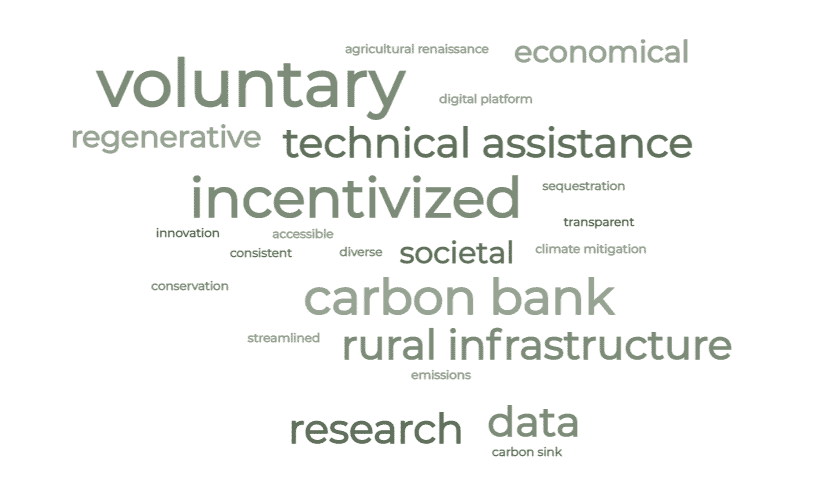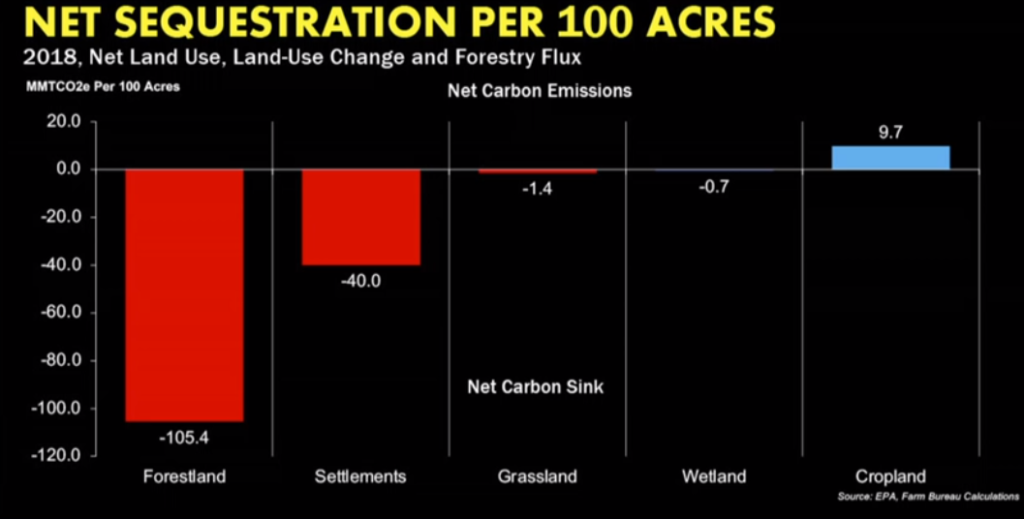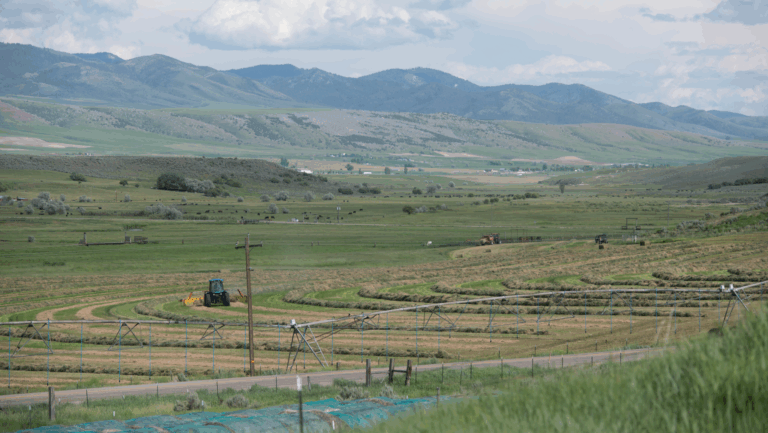2021 Ag & Food Policy Summit Recap: Climate Risks, Rewards, and Ag Finance
Last week, farm leaders, innovators, and policymakers came together to discuss the trending topic of sustainability in American agriculture.
AgAmerica had the opportunity to listen in on the annual Agri-Pulse Ag & Food Policy Summit this year and it did not disappoint. From key policymakers to innovative farmers throughout the U.S., experts from varying perspectives came together to discuss what a sustainable future for American agriculture means to them.
The focus this year was centered around the topic of climate change and attracted nearly 1,100 attendees. The key question addressed by panelists was, how can American farmers be better equipped to be one of the biggest allies in reversing the course of global climate change?
According to Professor Dr. Frank Mitloehner at the University of California, Davis, and Ag Summit Panelist, agriculture is on the path towards climate neutrality in the next ten years if American farmers are supported in their regenerative endeavors. Each speaker brought unique insights into the mix yet shared an underlying voice of unison with their words.

Throughout the three-day summit, panelists and guest speakers shared their perspective on how American farmers can lead the way in sustainability. Here’s what stuck out to us the most.
The Importance of Data and Scalable Infrastructure
Nearly every speaker spoke on the importance of data to collect measurable results and minimize risk for farmers. Funding for research and education is vital in the development of regenerative agriculture because without it, we won’t know how successful certain practices are. This investment in innovation would provide the resources needed to scale the revolutionary technology that already exists.
For example, Dr. Mitloehner and American Farm Bureau’s Chief Economist Dr. John Newton were both proponents for the use of anaerobic digestors on dairy cattle operations as a way of reducing methane emissions and transforming it into renewable energy that can power equipment. However, currently a dairy operation must have a herd size of at least 6,000 cattle to even begin making the cost worth it. They hope to see these types of innovative technology scaled down in a way that can benefit farms of all sizes.
Data-centric initiatives can also help dispel misinformation and spread educational awareness through fact-based science. Leslie Sarasin, CEO of the Food Industry Association (FMI), referred to consumer misconception of genetic engineering. The large majority of consumers dismiss the use of genetically modified food products, without understanding the potential of genetic engineering to optimize our food production for a global population. For instance, the “N8 potato” was genetically engineered to be less sensitive to bruising, thereby reducing waste and making storage easier for potato farmers.
The Bottom Line: Investment and education are critical components to widespread acceptance of regenerative practices that are affordable and accessible for American farms of all sizes.
The Carbon Bank: Drawbacks and Solutions
From Ag Secretary Tom Vilsack to Farm Bureau Chief Economist Dr. Newton, the carbon bank initiative was brought up in nearly every session during the summit. President and CEO of Nutrien Chuck Magro noted several factors that are key to the success of carbon banks:
- Programs must be developed by farmers to work for farmers;
- Measurements must be clearly defined and easily understood;
- A third-party evaluator is needed to keep the market unbiased and consistent;
- The ability to trade carbon as a form of currency would increase carbon buyers;
- Increases in technological support and research investments will be needed; and
- Access to a digital platform to streamline the process.
The more the carbon concept was discussed, the more factors to consider emerged. According to Dr. Newton, there are currently 202 million conservation till acreage in the U.S., which led to the question of how to not leave early adopters out.
Co-Founder of Continuum Ag, Mitchell Hora, had an interesting point—farmers should be paid on total carbon footprint, rather than their specific practice on a farm. As an innovator in the regenerative agriculture sector, Mitchell has explored these practices on his family farm in Iowa since his grandfather purchased his first no-till drill in 1986. He pointed out that he has reaped the benefits of these practices with lower input costs and healthier soil, and does not expect to be paid for early adoption. However, measuring carbon credits with net annual carbon sequestration on a farm would reward early adopters who have had a jumpstart towards a net-zero operation, encouraging others to do the same. It would also allow room for innovation and creativity from farmers who are in the fields every day, are experts in their local soil, and are the most resourceful group of individuals that exist.
Marty Matlock, Professor and Executive Director at the University of Arkansas Resiliency Center, also noted that there is a huge range of soil types throughout USDA regions, subregions, and even on a state and county level. This plethora of soil diversity means that the carbon market must be flexible and inclusive to provide all American farmers with equal opportunity and access.
Despite these challenges, interest among farmers to secure carbon contracts is high, as the Global Head of Carbon at Indigo Ag, Dr. Chris Harbourt confirmed. Indigo Ag is one of the first private companies spearheading the growth of private carbon markets. Dr. Harbourt said their program is in its first year of generating credits with American growers who are supplying more than two million acres of opportunity to sequester carbon throughout 21 states.
The Bottom Line: While ripe with opportunity and interest among farmers, sticking points in the carbon markets include deciding a universal measurement method and providing access to upfront capital for farmers to transition their operations. Alternative lenders, such as AgAmerica, will likely play a key role in creating flexible financing that allows American farmers to tap into the carbon market, while minimizing the risk that comes with transitioning their operational practices.
Opportunity in the American Forestry Sector
While carbon markets were heavily discussed throughout the course of the summit, it was not the only climate solution industry experts saw in the agricultural sector. One industry that has flown relatively under the radar in its essential role of carbon mitigation is the American forestry sector.
According to Dave Tenny, founding President and CEO of National Alliance of Forest Owner, privately-owned working forests can be a top player in carbon emission mitigation. Currently, U.S. forestry is the only carbon sink within the agriculture industry and sequesters anywhere from 12 to 16 percent of total domestic production emissions.
Tenny reported that there is approximately 20 times more sequestration coming from privately-owned forests than federal forests due to more optimized forest management, conservation regulations, and a 90 percent compliance rate among private forest owners. In fact, he shared that the biggest fear among forest landowners is a fire that starts on neighboring federal land as it burns at a much faster and destructive rate.
Dr. Newton echoed Tenny’s insights in his later presentation, reporting that emissions and land use in agriculture have been steadily declining since 1990 due to optimization and innovation in the market. He said that forestlands and settlements (forestland that is surrounded by developed land) are the largest carbon sink with the highest sequestration potential.

While carbon sink efforts are headed in the right direction, Dr. Newton said they would need to increase tenfold to offset total U.S. emissions. He also stated firmly that set aside programs were not the solution. These programs pressure farmers to allocate a portion of their land to conservation use. This sounds good in theory, however, puts American farmers at a disadvantage in the global market and destabilizes our domestic food and suppy security.
Not only that, but when there aren’t enough croplands in the U.S., they are outsourced to other countries with less conservation efforts in place. For example, Brazilian cropland has nearly doubled from 2000 to 2014 and led to severe deforestation.
However, even though set aside programs would only exacerbate these issues, proper forest management of public and private forests is highly opportunistic. But it will require federally-funded expansion of existing conservation programs. During a poll, the majority of Food and Ag Policy Summit attendees believed $30 to $50 billion more funding should be allocated to conservation efforts – with 36 percent believing $50 billion will be needed.
The Bottom Line: The U.S. forestry industry is one of the biggest allies in the fight against climate change through proper forest management and an increase in funding for existing conservation programs. It is important to note that set aside programs should be used with caution to protect our domestic food supply and discourage deforestation in other countries.
How Ag Finance Can Help Push the Needle Towards a Climate Solution
The agricultural renaissance is here, as A.G. Kawamura, Founding Co-Chair of Solutions from the Land, so eloquently said. America is a leader in the global agricultural community and continues to shape the path of innovation in the regenerative sector. Many farmers are already hard at work implementing these practices even with a lack of resources and data to support them. They are pushing the needle forward beyond climate mitigation and into the realm of a climate solution as a negative carbon industry–but they shouldn’t have to do it alone.
The Food & Ag Policy Summit was a timely reminder that the future of American agriculture is bright. AgAmerica is here to help by providing a wide spectrum of flexible financing solutions that can adapt and evolve alongside each unique operation. From our 10-year line of credit to our cash out refinance program, we have a singular focus on agricultural land lending to provide farmers, ranchers, and rural landowners with the capital they need to achieve their sustainability goals.
If you are interested in partnering with a lender who is committed to helping farmers across the nation thrive, contact us today.






